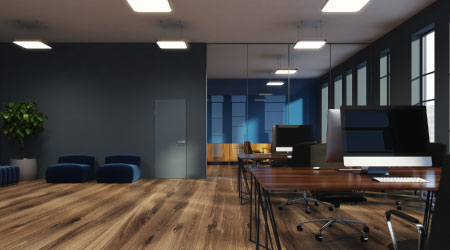How To Select The Right Commercial Flooring Product
Nothing in a commercial space gets as much abuse as the flooring material. The right product may never show how much traffic and use it really gets. The wrong product will make you want to pull your hair out when it fails miserably after a short period of time. Getting the right flooring product into the right place can be very challenging, particularly if you don't fully understand all the circumstances, conditions, and parameters of what you want to use, where it will be used, and how it should be used. These steps can help you get select the right commercial flooring product that meets all your expectations.
Understand substrate conditions. Substrate problems are a significant and complex challenge. The key: the substrate must be clean and dry (no moisture issues) and free of any substances or conditions that could compromise installation of flooring material.
Understand your goals. If you are replacing existing flooring, here are some questions to answer: What do you have now? What do you like about it, if anything? What don't you like? Why are you replacing it? Is it ugly, worn, or dated? Do you want something that looks similar to maintain a color scheme or are you after a completely new look?
It is always an excellent idea to install a mock up, with flooring materials being considered, to see how they perform.
Categorize traffic. Light traffic could be private offices or limited use spaces. Moderate could be secretarial or meeting room spaces. Heavy could be corridors, offices, call centers, or entryways. Severe could be public spaces, lobbies or dining areas, transportation, amusement, entertainment or sports venues.
Traffic will dictate the range of colors you can use, construction of the material, and style. Very dense carpet or high performance vinyl flooring, stone, or terrazzo would be the product choices for very high or severe traffic. Even with lighter traffic the denser the product, the better it should perform. And the less traffic there is, the more comfortable a flooring material can be with use of a cushion or a cushioned backing.
Use hard or soft surface flooring? In entryways, consider a hard surface product coupled with an entry-type flooring material at the doorways. From there a soft surface product could be used. With natural products, you have to know what to use where and what the natural characteristics are. Wood can scratch and dent. Cork can turn color, as can linoleum when exposed to volumes of UV light.
Even with traditional materials, it is essential to be aware of conditions in the space. Hard surface flooring in hospitals, for example, especially patient rooms with very heavy beds and very heavy patients, can indent. In these cases, you have to be very careful to work with the flooring manufacturer to ensure you use the right components with the floor and select exactly the product that will work. There is new PVC-free flooring that will not indent and that is installed with no adhesive out of a container.
When it comes to carpet, you have to decide whether to use cut or loop pile carpet or a combination. Loop pile carpet, especially if low and dense, will always outperform cut pile carpet. However, a combination of cut and loop in the right construction will also deliver high performance with greater styling.
Related Topics:













